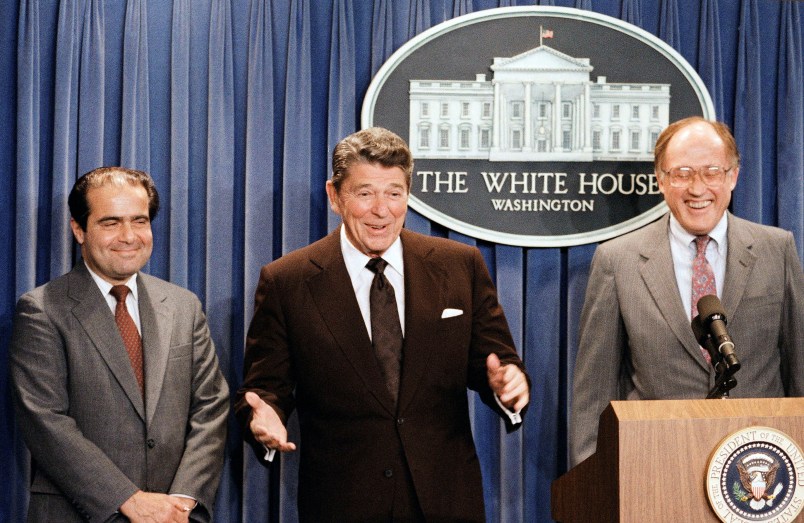Senate Republicans can claim some precedence for blocking any of President Obama’s nominees to replace the late Justice Antonin Scalia until a new president is elected — if they reach back to the mid-1800s.
The GOP’s insistence — immediately upon news of Scalia’s death — that the Supreme Court must wait until the next president to gets its ninth seat refilled is not unprecedented, but is nonetheless very rare. In fact, all the unsuccessful Supreme Court nominees of the last century ran into problems because of their own traits, rather than some arbitrary obstruction aimed at the president.
The closest comparison to the wholesale rejection President Obama is about to face with his nominee is President John Tyler, who holds the unenviable record of having four of the five men he put forward fail to make it to the Court. The fight was part of a larger clash between Tyler and the Whig-controlled Senate, where Whig lawmakers hoped Sen. Henry Clay of Kentucky would win the next presidential election in 1844.
Over the course of 15 months in 1844 and 1845, in an effort to fill two Supreme Court vacancies, Tyler submitted and resubmitted his nominees a total of nine times. Samuel Nelson was finally confirmed in the last weeks of Tyler’s presidency. But the second vacancy wasn’t filled until well after Tyler left office, with the confirmation of Robert Cooper Grier in 1846, more than two years after the seat was opened up by the death of Henry Baldwin. It seems unlikely the Scalia vacancy will break that record, assuming the Senate takes up a nomination in the months after the 2017 inauguration.
The next closest scenario is what happened to President Andrew Johnson’s 1866 nomination of his Attorney General Henry Stanbery, who was otherwise well-liked by lawmakers. The Senate, however, did not like Johnson, so it opted to pass legislation that reduced the number of seats on the Supreme Court from 10 to seven, preventing Stanbery from ever being considered.
In 2010, the Congressional Research Service issued a report studying the circumstances of Supreme Court nominees who were not confirmed. It found that out of the 36 times a president’s Supreme Court nominee was not confirmed by the Senate, the Senate’s opposition to the president himself played a role 16 times. Seven of those nominees — all in the 19th century — were submitted during a president’s lame-duck period between the election and the inauguration of the new president.
Opposition to the nominating President played a role in at least 16 of the 36 nominations that were not confirmed. Many of the 16 were put forward by a President in the last year of his presidency—seven occurred after a successor President had been elected, but before the transfer of power to the new administration. Each of these “lame duck” nominations transpired under 19th century Presidents when the post-election period lasted from early November until early March.
In some of those cases — like President John Quincy Adams’ nomination of John Crittenden or President Rutherford B. Hayes’ nomination of Stanley Matthews — those nominees were confirmed once the new president took office.
In the last century or so, the nominees who have not been successful faced obstacles having to do with their own records — many of them blocked or withdrawn over concerns about past resistance to civil rights.
Since the 1800s, only Homer Thornberry saw his nomination fail for reasons not related to his own record of activities. He was nominated in 1968 by President Lyndon Johnson to take the associate justice chair of Abe Fortas, who Johnson had nominated to replace the retiring Chief Justice Earl Warren. Fortas was forced to withdraw as the chief justice nominee because of a personal controversy but kept his associate justice seat, making Thornberry’s nomination moot.











1800s should refer to the decade, not the century.
Mid-1840s would have worked.
So in other words, this is unprecedented in both the 20th and 21st century. Yeah, its been a very long while. So fuck these Republicans and their bullshit ways to nullify the constitutional authority of this President to put forth an appointee to the court and have that appointee get a fair and impartial hearing.
Since these Republicans exist entirely in an obsolete and archaic era, this precedent seems perfectly recent.
Well, this just makes sense, doesn’t it – they want to take us back to the 19th century, and they reach back to the 19th century for precedent to help them do so.
Seriously, though, boy oh boy did they blow the optics on this one! By announcing they won’t accept any nominee from Obama before one has even been proposed, they reveal themselves as knee-jerk partisans, and by promising to disrupt the business of the highest court of the land for more than a year, they’ve positioning themselves as champions of gridlock.
The “smart” move would have been to say that they’d look carefully at whoever the President nominates, but that the Senate takes its role of advice and consent very seriously, yada, yada. Go through the motions of holding confirmation hearings, as slowly as possible, and then once the confirmation hearings are wrapped up and there are no more excuses for delay, reject the nominee, declaring them to be unqualified, or loony left or corrupt, or whatever. By then you’re a a few months down the line, and if Obama puts up another nominee, just rinse and repeat, that takes you past the election, If the Republican candidate wins the Presidency, the Republican Senate doubles down and keeps rejecting whoever Obama puts up.
Now they may very well still try to pursue this strategy, but they’ve already tipped their hand by declaring up front that they won’t be giving any nominees a fair hearing, that they aren’t going to be acting in good faith.
But…they just couldn’t help themselves.
“It seems unlikely the Scalia vacancy will break that record, assuming the Senate takes up a nomination in the months after the 2017 inauguration.”
Why? If a Democrat wins the presidency, why would these pathetic morons suddenly give in and accept a nomination? They can just block and block for the next 4 to 8 years. Or 12 or 16 . . . whatever. If their belief is good enough to exploit for a year, it’s good enough to exploit for another four.